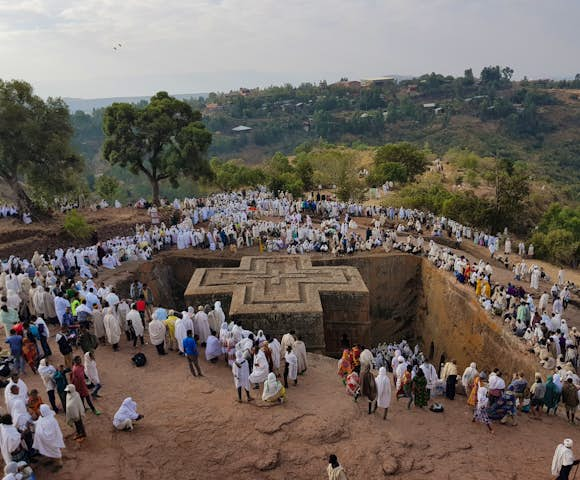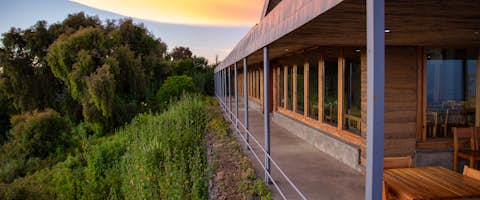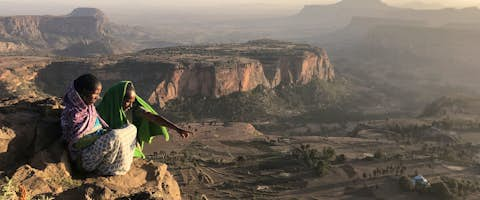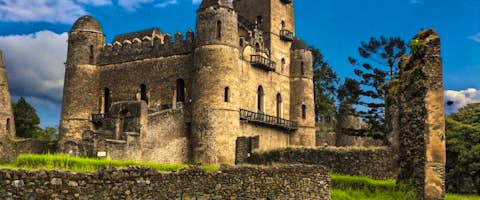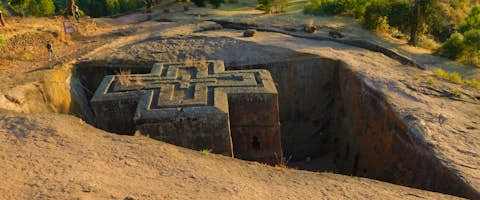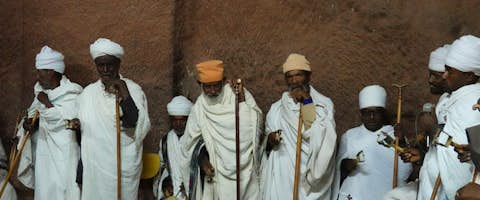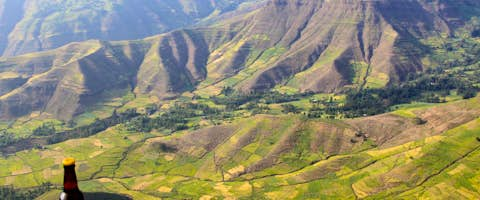Origins
Occupying a roughly triangular 15 hectare site either side of a rock-cut stream known locally as the Jordan River, the rock-hewn churches in Lalibela are found in two main clusters with the magnificent Bet Giyorgis standing in glorious isolation about 300 metres from the other churches.
The northern cluster of seven churches and chapels seem to have a much greater cohesion and sense of order. Some argue this supports the idea that it was constructed from a cogent plan, perhaps made by a powerful ruler like King Lalibela.
The southern cluster, found 250 metres from the northern cluster, is made up of seven churches. Here order is less visible. Symmetry is rare. Steps and hand holds have been worn wide and smooth by constant use. It feels older; the explanations for the churches and tunnels are less certain, which creates room for imagination.
Architecturally, the churches of the northern cluster are subterranean monoliths or three-quarter monoliths. The walls have been dug from the surrounding rock on three of four sides before the interiors are then ground away to amazing effect. The remaining churches have been cut into existing rock faces, fissures and caves; a simpler form of construction that also indicates greater antiquity.
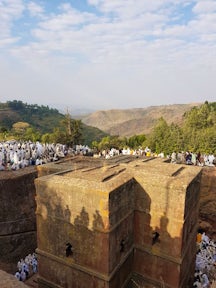
Top Trips to Lalibela

Brilliant says
Most visitors allow two days to visit the churches and wander through the neo-biblical landscape. This allows time for you to visit each of the churches and then return to those you find most compelling, or just sit quietly as a service plays out, oblivious to your presence.
Northern Cluster
Bet Medhane Alem (House of the Saviour of the World)
This is the first church you will encounter after leaving the ticket office. It is reputedly the largest free-standing rock church in the world and has a beautiful architectural simplicity.
Internal and external pillars surround a relatively plain building reminiscent of a Greek temple. It is surrounded by a wide courtyard whose walls are marked with carved graves or monks' cells.
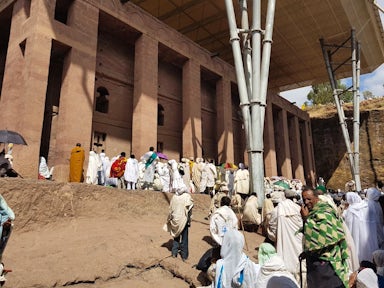
Biete Medhane Alem, the world's largest free-standing rock church.
Bet Maryam (House of Mary), Bet Meskel (House of the Cross) and Bet Denagel (House of Virgins)
Who wouldn’t want to visit a sacred pillar inscribed in two languages with the story of the construction of Lalibela and the Twelve Commandments? Especially if it glowed brightly until the 16th century, at which point it was veiled, never to be seen again. The pillar is found in Bet Maryam, a 10-metre high carved church, accessed by a short low tunnel from Bet Medhane Alem. Legend has it that this was the first church carved in Lalibela, and it remains a popular focus of pilgrimage today.
Sharing the courtyard, carved into the rock, is the tiny chapel of Bet Meskel and the even smaller Bet Dengal. The last was allegedly built to honour the memory of 50 Christian nuns murdered by the Roman ruler, Julian the Apostate in the 4th century.
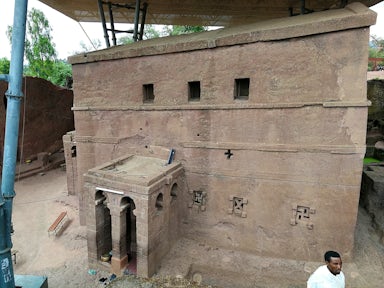
Bet Golgotha and Mikael (House of Golgotha Mikael)
On the west of the northern cluster, you will find the twin churches of Golgotha and Mikael, containing within Golgotha the tiny chapel of Selassie where King Lalibela is reputedly buried. You will have to take the word of the priests for this because the chapel is traditionally closed to non-ecclesiastical visitors.
The two churches share a common entrance and form a semi-monolith. As with much of Lalibela, their origin and purpose is disputed but the heavy sense of sanctity as you walk slowly around is undisputed. Some say the churches were carved by Lalibela; others argue that they were built in the 15th century to mark the elevation of the late King by the Ethiopian church.

Biete Giyorgis (House of Saint George)
It doesn’t do to offend a saint. Legend has it that Lalibela was so busy constructing and dedicating his churches that he forgot to allocate one to Saint George. This prompted a visit from the aggrieved saint to the King. Alarmed, Lalibela swiftly set about building the famous cruciform church you see today. Ask your guide about the hoof prints left by George’s horse.
Lalibela did a great job. The church is 15 metres high, the roof flush with ground level, the building surrounded by a courtyard with sheer rock walls. The visually impressive exterior is complemented by a contrastingly simple, but atmospheric interior. Come here at dawn if you can stomach the early morning.

Pilgrims gather around Biete Giyorgis, Lalibela.

Brilliant says
800 years of weather and water has taken its toll on the churches and so now you will see translucent plastic shelters erected to protect them from further damage. They aren’t pretty, but until a better replacement can be designed, they are important, so forget them and concentrate on what lies beneath.
Southern Cluster
Bet Gabriel Raphael (House of Gabriel Raphael)
The church as a spiritual fortress is a well-known concept, but combining the two is rare. As the Axumite Empire collapsed in the political turbulence of the 7th and 8th centuries, it is thought that Bet Gabrial could have been a fortified palace for Lalibela.
The high walls and excavated trench, which fills with water in the rain, create an impressive approach, while the interior is relatively simple and suitably mysterious. We would tell you how to get to the hidden rooms below, but the priests have forgotten how to access the secret tunnel.

Bet Abba Libanos (House of Abbot Libanos) and Bet Leham
Built around a cave in a vertical rock face, the roof is still connected to the original rock, while the tunnels separate the sides and back. Legend credits Mesekel Kibre, Lalibela’s wife, with the construction, possibly assisted by angels.
A 50-metre tunnel links Libanos to the smaller Bet Leham, more of a monastic cell than a church, but it doesn’t take much to imagine a King enjoying its privacy in moments of prayer.
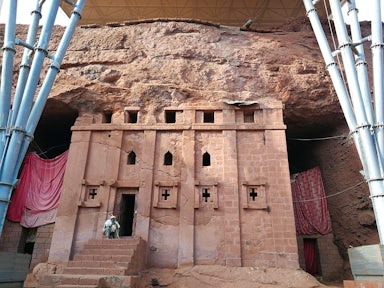
Priest guards the entrance to Biete Abba Libanos, Lalibela.
Bet Emanuel (House of Emmanuel)
Lalibela’s homage to old Axum, Bet Emanuel is the only full monolith in the southern cluster. 12 metres high and precisely decorated, it is thought to have been the private church of the royal family. It is easy to imagine the wide courtyard full of retainers and the pageant of imperial festivals. Now hermits cells have been carved into the soft rock and in abandoned niches old bones can be clearly seen.
Inside the church, there’s a beautiful staircase to an upper gallery, although access is currently restricted. In the Southwest corner of the church, a since-closed passage descends underground connecting to the Biete Merkorios church.

Bet Mercurios (House of Saint Mercurios)
If Bet Gabriel-Rafael was the palace, then perhaps Bet Mercurios was the jail or the courtroom - no other church has evidence of iron shackles embedded in its surrounding trench.
This cave church is dedicated to Mercurious, a 3rd century Coptic saint who was tortured and beheaded for his Christian beliefs by the Emperor Decius, going onto play a starring role in the death of the apostate Emperor Julien a century later. The church is dilapidated, with a re-built entrance and a faded interior, but its approach via a 35-metre unlit tunnel from Bet Babriel-Rafeal is remarkable. Done without a torch, it is another of those tests of faith that Ethiopians specialise in and is said to mimic a passage through Hell, emerging into the light of the church.
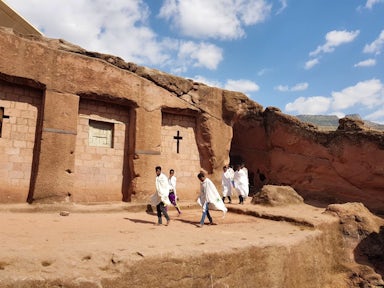
Priests exit Biete Mercoreus Church.
Exploring the Churches
Lalibela is best explored on foot. The churches are located relatively close to one another and most of the hotels are still within town. However, a few steep slopes and the high altitude may leave you feeling breathless, so we include a vehicle and driver to close the gaps where necessary.
If you are exploring town in the evening, then a local bajaj, three-wheeled motorbike taxi, is a fun way to get around. Just ask your hotel or guide to grab one for you. Note: Bajaj drivers will charge you more if you're a tourist, so it's best to let your guide or hotel order it on your behalf if you want to save pennies.
An experienced local guide, employed by an official local guide association, will be included in your stay as well as the cost of a permit to visit the churches, which is valid for up to five days. Your guide will provide knowledgeable and entertaining tours of the churches, but you are also welcome to return unaccompanied to enjoy a more contemplative experience on your own. Just keep your receipt to avoid being charged again.
Your guide will also co-ordinate excursions out into the hills, whether community trekking in Lalibela or a hike to Hudad Lodge, or whether visiting the monasteries of Asheton Maryam, Yemrehane Krestos, or Na’akuto La‘ab.

Top Trips to Lalibela
Ready to plan your Ethiopia adventure?
Listen
We'll spend some time listening to your aspirations, then discuss the kind of experience that might suit you.
Match
Next we'll discuss the options, shortlist the best trips for you and present you our impartial recommendations.
Reserve
We'll place a 24 hour hold on your preferred option - without obligation - whilst we talk through the details.
Whatever your budget, group size, length of stay, preferred activity or appetite for adventure, we can help.
+1 315 645 2889














